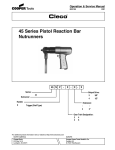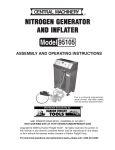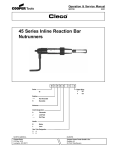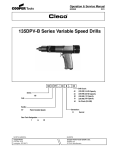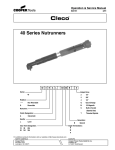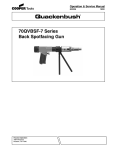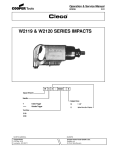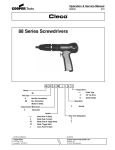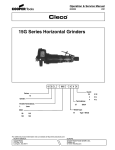Download P-15 & MP-15 SERIES POWER TOOL ANALYZER
Transcript
Operation & Service Manual 823173 2/01 P-15 & MP-15 SERIES POWER TOOL ANALYZER XX-15 Series: Order Number: P-15 Inch Pounds Newton-Meters (4-160) (.5-18) 810002 MP-15 Centimeter-Kilograms (5-180) 810151 Newton-Meters (.5-18) For additional product information visit our website at http://www.clecotools.com NORTH AMERICA CooperTools P.O. Box 1410 Lexington, SC 29071 EUROPE Cooper Power Tools GmbH & Co. Postfach 30 D-73461 Westhausen 1 Safety Recommendations For your safety and the safety of others, read and understand the safety recommendations and operating instructions before operating a nutrunner. Always wear protective equipment: ! WARNING Impact resistant eye protection must be worn while operating or working near this tool. For additional information on eye protection and face protection, refer to Federal OSHA Regulations, 29 Code of Federal Regulations, Section 1910.133., Eye and Face Protection, and American National Standards Institute, ANSI Z87.1, Occupational and Educational Eye and Face Protection. Z87.1 is available from the American National Standards Institute, Inc., 25 West 43rd Street, 4th floor, New York, N.Y. 10036. ! CAUTION When using right angle nutrunners, be sure the throttle is positioned relative to the angle head so that the throttle will not become wedged against an adjacent object in the "ON" position due to torque reaction. The angle head may be repositioned with respect to the lever to accommodate proper location for task. If tool is to be reversed, locate throttle lever in a neutral position that will prevent entrapment. Refer to operating instructions for additional information. It is essential for safe operation that any operator of a nutrunner use good balance, sure footing, and proper posture in anticipation of a torque reaction. Tools with clutches can stall rather than shut-off if adjusted over maximum power output of tool, or if there is a drop in air pressure. Operator must then resist stall torque until throttle is released. CAUTION Personal hearing protection is recommended when operating or working near this tool. Hearing protection is recommended in high noise areas 85 dBA or greater. The operation of other tools and equipment in the area, reflective surfaces, process noises and resonant structures can substantially contribute to, and increase the noise level in the area. Excessive air pressure above 90 PSIG or worn motor components can also increase sound level emitted by tool. Proper hearing conservation measures, including annual audiograms and training in the use and fit of hearing protection devices may be necessary. For additional information on hearing protection, refer to Federal Regulations, Section 1910.95, Occupational Noise Exposure, and American National Standards Institute, ANSI S12.6, Hearing Protectors. Cleco nutrunners are designed to operate on 90 psig (6.2 bar) maximum air pressure. If the tool is properly sized and applied, higher air pressure is unnecessary. Excessive air pressure increases the loads and stresses on the tool parts, sockets, and fasteners and may result in breakage. Installation of a filterregulator-lubricator in the air supply line ahead of the tool is recommended. Before the tool is connected to the air supply, check the throttle for proper operation (i. e., throttle moves freely and returns to closed position). Being careful not to endanger adjacent personnel, clear the air hose of accumulated dust and moisture. Before connecting a tool to the air hose, removing a tool from service or changing sockets, make sure the air line is shut off and drained of air. This will prevent the tool from operating if the throttle is accidently engaged. 2 ! Spindle Rotation Torque Reaction Tool balance arms are available to absorb the torque reaction of the tool while balancing the weight of the tool for improved ergonomic applications. ! WARNING Repetitive work motions and/or vibration may cause injury to hands and arms. Use minimum hand grip force consistent with proper control and safe operation. Keep body and hands warm and dry. Avoid anything that inhibits blood circulation. Avoid continuous vibration exposure. Keep wrists straight. Avoid repeated bending of wrists and hands. Some individuals may be susceptible to disorders of the hands and arms when performing tasks consisting of highly repetitive motions and/or exposure to extended vibration. Cumulative trauma disorders such as carpal tunnel syndrome and tendonitis may be caused or aggravated by repetitious, forceful exertions of the hands and arms. Vibration may contribute to a condition called Raynaud's Syndrome. These disorders develop gradually over periods of weeks, months, and years. It is presently unknown to what extent exposure to vibrations or repetitive motions may contribute to the disorders. Hereditary factors, vasculatory or circulatory problems, exposure to cold and dampness, diet, smoking and work practices are thought to contribute to the conditions. Any tool operator should be aware of the following warning signs and symptoms so that a problem can be addressed before it becomes a debilitating injury. Any user suffering prolonged symp Safety Recommendations toms of tingling, numbness, blanching of fingers, clumsiness or weakened grip, nocturnal pain in the hand, or any other disorder of the shoulders, arms, wrists, or fingers is advised to consult a physician. If it is determined that the symptoms are job related or aggravated by movements and postures dictated by the job design, it may be necessary for the employer to take steps to prevent further occurrences. These steps might include, but are not limited to, repositioning the workpiece or redesigning the workstation, reassigning workers to other jobs, rotating jobs, changing work pace, and/or changing the type of tool used so as to minimize stress on the operator. Some tasks may require more than one type of tool to obtain the optimum operator/tool/task relationship. The following suggestions will help reduce or moderate the effects of repetitive work motions and/or extended vibration exposure: • Use a minimum hand grip force consistent with proper control and safe operation • Keep body and hands warm and dry (cold weather is reported to be a major factor contributing to Raynaud's Syndrome) • Avoid anything that inhibits blood circulation —Smoking Tobacco (another contributing factor) —Cold Temperatures —Certain Drugs Avoid Extension OK Neutral Avoid Flexion Avoid Radial Deviation OK Avoid Neutral Ulnar Deviation A booklet, Assembly Tool Ergonomics, is available free of charge by writing the following address: Cooper Tools P. O. Box 40430 Houston, Texas 77240 USA 713/462-4521 Please request Form No. 60669. For more information on the safe use of portable air tools, see the latest edition of ANSI B186.1, Safety Code for Portable Air Tools, available from the American National Standards Institute, Inc. 11 West 42nd Street, New York, N.Y. 10036. This information is a compilation of general safety practices obtained from various sources available at the date of production. However, our company does not represent that every acceptable safety practice is offered herein, or that abnormal or unusual circumstances may not warrant or require additional procedures. Your work may require additional specific safety procedures. Follow these procedures as required by your company. Warning Labels The warning labels found on these tools are an essential part of this product. Labels should not be removed. Labels should be checked periodically for ligibility. Replace warning labels when missing or when the information can no longer be read. Replacement labels can be ordered as any spare part. • Tasks should be performed in such a manner that the wrists are maintained in a neutral position, which is not flexed, hyperextended, or turned side to side. • Stressful postures should be avoided — select a tool appropriate for the job and work location • Avoid highly repetitive movements of hands and wrists, and continuous vibration exposure (after each period of operation, exercise to increase blood circulation) • Keep tool well maintained and replace worn parts Work gloves with vibration reducing liners and wrist supports are available from some manufacturers of industrial work gloves. Tool wraps and grips are also available from a number of different manufacturers. These gloves, wraps, and wrist supports are designed to reduce and moderate the effects of extended vibration exposure and repetitive wrist trauma. Since they vary widely in design, material, thickness, vibration reduction, and wrist support qualities, it is recommended that the glove, tool wrap, or wrist support manufacturer be consulted for items designed for your specific application. WARNING! Proper fit of gloves is important. Improperly fitted gloves may restrict blood flow to the fingers and can substantially reduce grip strength. 3 OPERATING AND SERVICE INSTRUCTIONS FOR P-15 AND M-P-15 ANALYZER OPERATION The P-15 Analyzer consists of a heavy metal housing enclosing a torsion absorbing and dial indicating mechanism. A means is provided to drive into the analyzer with power screwdrivers and to hold and observe the torque obtained until manually released by the operator. The tool should be removed from the drive post before the brake is released. Attach a 5/16 six point power socket to drive shaft of screwdriver. Engage socket to drive post of analyzer and power drive to torque release. Pointer will read directly in inch pounds. In operation, the power screwdriver winds the torsion spring which absorbs the revolutions of the screwdriver and transmits the applied torque to the torsion bar. This in turn is registered by the pointer on the dial face. When terminal torque is reached, the pointer is held by an overrunning clutch. The brake on this clutch is manually released by the hand lever. The tool should be removed from the drive post before the brake is released. When released, the pointer will return to two inch pounds. The brake is automatically tightened when not manually held open. The torque output of clutch type screwdrivers up too 2000 R.P.M. can be accurately checked with the P-15 Analyzer. Higher R.P.M. tools of this type will tend to cause the analyzer to be erratic. The stall torque of direct drive tools considerably higher than 2000 R.P.M. can also be checked. Holding flywheel firmly, install test wheel with cable hanging from right side, and turn clockwise until pointer indicates 10 inch pounds (11.5 cm. kg.). Hang 2 1/2 pound counterpoise on cable. Remove flywheel assembly from analyzer by pulling up and rotating slightly to disengage worm gear. Pointer should now indicate 10 inch pounds (11.5 cm. kg.). Reinstall flywheel assembly, rotating slowly to engage worm gear. Grasp flywheel firmly and turn analyzer drive post clockwise until pointer indicates 30 inch pounds (34.5 cm. kg.). In the higher range of the analyzer, it is recommended that a wrench and 5/16 socket be used to wind up analyzer. Install test wheel, counterpoise and 5 pound weight. Remove flywheel assembly and observe reading. Pointer should indicate 30 inch pounds (34.5 cm. kg.). Repeat the above procedure and using 70 inch pounds (80.6 cm. kg.) 110 inch pounds (127 cm. kg.) and 150 inch pounds (173 cm. kg.) as check points and by adding a 10 pound weight each time. To return analyzer to two inch pounds, permit flywheel to slowly unwind in hand. CAUTION: Test wheel and weights should be removed from drive post before permitting flywheel to unwind. All readings should be within 1% plus 1/2 inch pound (1% plus 1cm. kg.) + or - of the applied load throughout the entire range. Should the analyzer be out of tolerance continue to calibration section. CALIBRATION With no load on analyzer, remove torsion bar retainer 27 and loosen cap screw 25 approximately three turns. DEAD WEIGHT TESTING Pull torsion bar 16 out approximately two inches. The only reliable method for checking the accuracy of the P-15 analyzer is by dead weight testing. A DWTS-150 (No. 810080) analyzer test kit is available for this purpose. It contains a precision 4 inch radius test wheel, one 2 1/2 pound counterpoise, one 5 pound weight and 3 ten pound weights. All weights are certified to class "T" tolerance (laboratory weights). Using the DWTS-150 analyzer test kit proceed as follows: Remove the two cap screws 60 from the flywheel housing 64. Depress the release handle 58 and lift the flywheel housing assembly off the analyzer. CAUTION: With the flywheel housing assembly removed, it is extremely important that the flywheel 63 be held by hand if any load either by wrench or test wheel is applied to the analyzer drive post 1. If the flywheel is not held, the wrench or test wheel will rotate in the reverse direction of loading when the load is released. 4 If pointer reads high, rotate torsion bar clockwise facing rear of analyzer. Turn one revolution for each one inch pound error at the 150 inch pound reading. If pointer reads low turn torsion bar counter-clockwise. Push torsion rod back into position, rotating slightly to "seek" socket at far end. Install test wheel and 21/2 pound counterpoise on analyzer and remove flywheel assembly. Rotate torsion bar until pointer reads exactly 10 inch pounds and tighten cap screw 25, to 215 inch pounds of torque. Replace torsion bar retainer and repeat dead weight test as described above. 5 DRIVE POST RETAINING RING LOCK COLLAR BALL BEARING CLUTCH RETAINER-FRONT PRECISION BALL 1/8 DIA. CLUTCH SHAFT CLUTCH RETAINER-REAR TORSION SPRING DRIVE TORSION SPRING BALL BEARING MAIN HOUSING TORSION BAR POINTER BASE WASHER SPACER BALL BEARING NYLON PLUG CAP SCREW 5/16—18 X 2-1/2 TORSION BAR ADJ. SCREW TORSION BAR RETAINER BALL BEARING WORM GEAR ROLL PIN PRECISION BALL 5/16 DIA. HEX NUT 7/16—14 SET SCREW CAM CLUTCH ASSY. NEEDLE BEARING DOWEL PIN ROLL PIN 1 1 1 1 1 76 1 1 1 1 1 1 1 1 *1-6 1 1 1 1 1 1 1 1 2 1 1 1 2 1 1 1 2 3 4 5 6 7 8 9 12 14 15 16 18 22 23 24 25 26 27 32 33 34 35 36 37 38 39 40 41 812294 812045 812046 812222 812047 844265 812049 812048 812043 812050 812219 812051 812052 812053 812054 812221 812055 812247 812056 812057 812220 812248 812245 844077 845842 812249 811015 812223 812228 619154 PART NO. * Number required is variable. O Circled items are available as a sub-assembly. Use Part No. 811014. NAME OF PART QTY. ITEM NO. QTY. 1 1 1 1 1 1 4 1 1 2 1 1 1 1 2 1 1 1 1 1 1 2 1 2 2 2 2 2 1 1 2 ITEM NO. 42 43 43 46 46 47 48 50 53 55 56 57 58 59 60 62 63 64 67 68 73 74 75 79 80 81 82 83 84 85 86 PARTS LIST FOR P-15 SERIES ANALYZER TUBE ASSY. DIAL FACE METRIC DIAL FACE NAME PLATE METRIC NAME PLATE DIAL HOUSING (INCL. 812077) CAP SCREW POINTER ASSY. SET SCREW ROLL PIN 1/4 DIA. BRAKE BAND CLAMP SET SCREW RELEASE HANDLE SPRING CAP SCREW BRAKE BAND FLYWHEEL & SHAFT FLYWHEEL HOUSING SET SCREW 3/8—16 X 1/4 RUBBER BUMPER RETAINING RING BELLEVILLE SPRING WASHER CAP SCREW RIVET DRIVE SCREW POINTER STOP SCREW SET SCREW 1/2—13 X 1/2 WASHER HANDLE EXTENSION BUTTON HEAD SCREW NAME OF PART 811016 812065 813222 812066 813223 812067 812241 811019 812069 812218 812070 812071 812072 812073 845758 812074 812075 812076 812246 812077 833774 812078 812079 833106 812783 812216 812336 812956 813318 203122 622059 PART NO. 6 NOTES 7 CooperTools 670 Industrial Drive Lexington, SC 29072 Phone: (803) 359-1200 Fax: (803) 359-2013 www.clecotools.com 8








